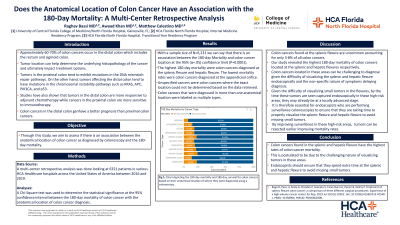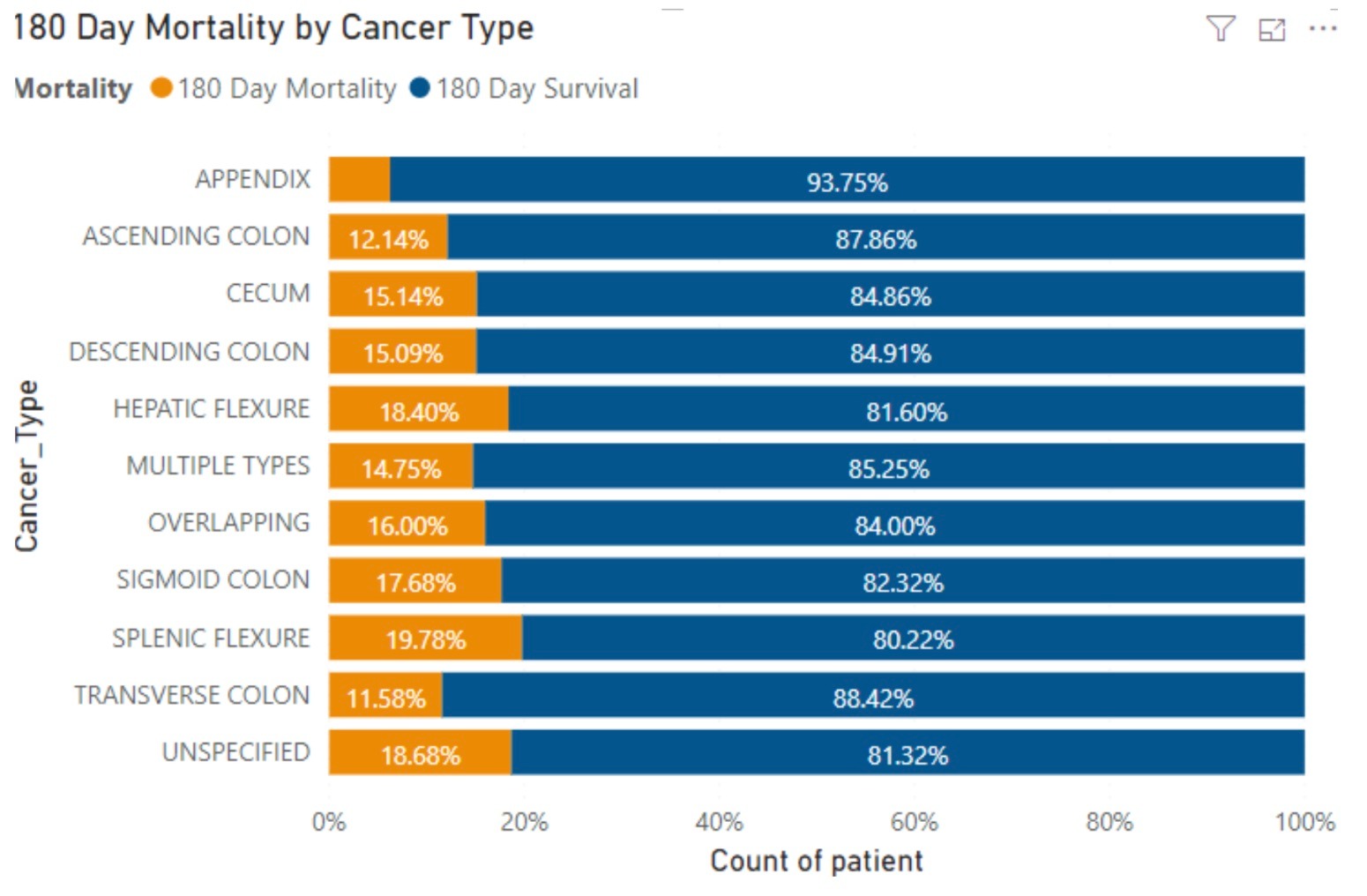Tuesday Poster Session
Category: Colon
P3044 - Does the Location of Colon Cancer Have an Association With the 180-day Mortality? A Multi-Center Retrospective Analysis
Tuesday, October 24, 2023
10:30 AM - 4:00 PM PT
Location: Exhibit Hall

Has Audio

Raghav Bassi, MD
University of Central Florida
Gainesville, FL
Presenting Author(s)
Raghav Bassi, MD, Awaad Khan, MD, Matthew Calestino, MD
University of Central Florida, Gainesville, FL
Introduction: Approximately 60-70% of colon cancers occur in the distal colon which includes the rectum and sigmoid colon. Tumor location determines the underlying histopathology of the cancer which directly impacts the mortality rate through treatment options available. Tumors in the proximal colon tend to exhibit mutations in the DNA mismatch repair pathways. On the other hand, tumors affecting the distal colon tend to have mutations in the chromosomal instability pathways such as KRAS, APC, PIK3CA and p53. Studies have shown that tumors in the distal colon are more responsive to adjuvant chemotherapy while cancers in the proximal colon are more sensitive to immunotherapy. Through this study, we aim to examine the 180 day mortality of colon cancers based on their anatomical location.
Methods: A multi-center retrospective analysis was done looking at 6,231 patients across various hospitals in the United States of America between 2016 and 2019. A Chi Square test was used to determine statistical significance between mortality and cancer type.
Results: With a sample size of N=6,231 we can say that there is an association between the 180-day mortality and the cancer type at the 95% (α=.05) confidence limit (P=0.0001). The highest 180-day mortality were cancers found in the splenic flexure and the lowest mortality with cancers near the appendiceal orifice. Unspecified cancers were colon cancers where the exact location could not be determined based on our data.
Discussion: Colon cancers found at the splenic flexure are uncommon accounting for only 3-8% of all cancers. Our study revealed a high 180-day mortality for cancers in this area which is postulated to be due to the challenging nature of visualizing tumors in the splenic flexure during a colonoscopy and the non-specific nature of symptoms delaying diagnosis. Furthermore, by the time tumors are identified in this area through a colonoscopy, they are already at an advanced age. It is therefore essential for clinicians who are performing surveillance colonoscopies to ensure that they can properly visualize the splenic flexure to avoid missing tumors in the early stage.

Disclosures:
Raghav Bassi, MD, Awaad Khan, MD, Matthew Calestino, MD. P3044 - Does the Location of Colon Cancer Have an Association With the 180-day Mortality? A Multi-Center Retrospective Analysis, ACG 2023 Annual Scientific Meeting Abstracts. Vancouver, BC, Canada: American College of Gastroenterology.
University of Central Florida, Gainesville, FL
Introduction: Approximately 60-70% of colon cancers occur in the distal colon which includes the rectum and sigmoid colon. Tumor location determines the underlying histopathology of the cancer which directly impacts the mortality rate through treatment options available. Tumors in the proximal colon tend to exhibit mutations in the DNA mismatch repair pathways. On the other hand, tumors affecting the distal colon tend to have mutations in the chromosomal instability pathways such as KRAS, APC, PIK3CA and p53. Studies have shown that tumors in the distal colon are more responsive to adjuvant chemotherapy while cancers in the proximal colon are more sensitive to immunotherapy. Through this study, we aim to examine the 180 day mortality of colon cancers based on their anatomical location.
Methods: A multi-center retrospective analysis was done looking at 6,231 patients across various hospitals in the United States of America between 2016 and 2019. A Chi Square test was used to determine statistical significance between mortality and cancer type.
Results: With a sample size of N=6,231 we can say that there is an association between the 180-day mortality and the cancer type at the 95% (α=.05) confidence limit (P=0.0001). The highest 180-day mortality were cancers found in the splenic flexure and the lowest mortality with cancers near the appendiceal orifice. Unspecified cancers were colon cancers where the exact location could not be determined based on our data.
Discussion: Colon cancers found at the splenic flexure are uncommon accounting for only 3-8% of all cancers. Our study revealed a high 180-day mortality for cancers in this area which is postulated to be due to the challenging nature of visualizing tumors in the splenic flexure during a colonoscopy and the non-specific nature of symptoms delaying diagnosis. Furthermore, by the time tumors are identified in this area through a colonoscopy, they are already at an advanced age. It is therefore essential for clinicians who are performing surveillance colonoscopies to ensure that they can properly visualize the splenic flexure to avoid missing tumors in the early stage.

Figure: Fig 1: The 180 day mortality and 180 day survival of various colon cancers based on their anatomical locations.
Disclosures:
Raghav Bassi indicated no relevant financial relationships.
Awaad Khan indicated no relevant financial relationships.
Matthew Calestino indicated no relevant financial relationships.
Raghav Bassi, MD, Awaad Khan, MD, Matthew Calestino, MD. P3044 - Does the Location of Colon Cancer Have an Association With the 180-day Mortality? A Multi-Center Retrospective Analysis, ACG 2023 Annual Scientific Meeting Abstracts. Vancouver, BC, Canada: American College of Gastroenterology.
